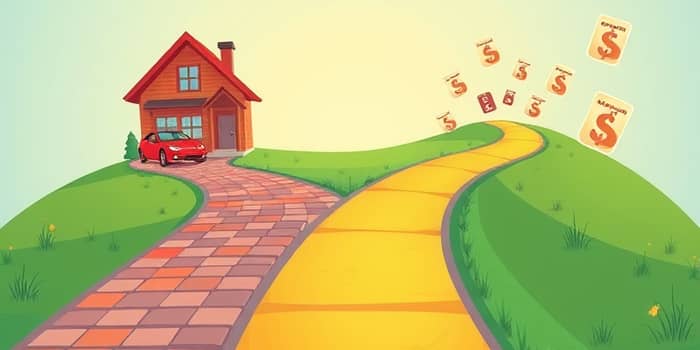Choosing the right loan can transform your financial journey. Understanding the nuances between secured loans require collateral and unsecured loans depend on creditworthiness empowers you to make informed decisions that align with your goals.
What Are Secured and Unsecured Loans?
At its core, a secured loan is one that is backed by an asset. Borrowers pledge something of value—such as a home, vehicle, or savings account—to guarantee repayment. If the borrower defaults, the lender can seize the asset to recover losses.
By contrast, unsecured loans rely solely on the borrower’s credit history and income. Without collateral at stake, lenders evaluate risk through credit scores, employment stability, and debt-to-income ratios.
Major Differences at a Glance
Comparing secured and unsecured loans side by side highlights the trade-offs in borrowing. The following table outlines their key features:
Types and Examples
Both loan categories encompass a variety of products designed for different needs. Below are common examples to illustrate the landscape.
- Secured Loans: Mortgages, auto loans, home equity loans/lines of credit, secured credit cards, secured personal loans
- Unsecured Loans: Personal loans, credit cards, student loans, medical loans, personal lines of credit
Interest Rates and Amounts
Interest rates on secured loans are generally lower because collateral reduces lender risk. In Australia, borrowers may secure rates between 6.5% and 9%. In the US, secured loans often stay below 10%, occasionally dipping to 5% for top-tier collateral-backed mortgages.
Unsecured loans must offset greater risk, resulting in higher interest rates for unsecured loans. Rates often start near 7% for borrowers with excellent credit but can climb above 19.99% for riskier profiles. Loan limits typically max out at $50,000 to $100,000.
Eligibility and Application Process
Secured loans accept lower credit scores thanks to backing collateral. However, the application can be lengthy, involving appraisals, legal documentation, and sometimes insurance on the pledged asset. The trade-off is often more favorable terms.
Unsecured loans demand better credit—usually at least a 580 score to qualify, with a 700+ score for prime rates. Approval is swift, often finalized within 24 to 48 hours, and requires minimal paperwork.
Pros and Cons
Secured loans offer lower interest rates due to collateral and higher loan amounts are possible, making them ideal for significant purchases like homes or vehicles. Qualification is easier to obtain with collateral. Yet, processing can be slow, and there is tangible risk of asset loss if you default.
Unsecured loans stand out for their no collateral needed approach and faster access to funds. Flexibility in fund usage is unmatched, but rates are steeper, and credit requirements are stricter. Defaults don’t threaten property directly but can lead to damage to your credit score and aggressive collections.
Risks and Consequences
When you choose a secured loan, the biggest danger is losing the pledged asset if you miss payments. Lenders can repossess a car or foreclose on a home to recoup funds. This can have profound personal and financial repercussions.
Unsecured loan defaults won’t result in immediate asset seizure, but missed payments can drastically lower your credit score, increase future borrowing costs, and potentially lead to collections or legal action.
Fees and Charges
Both loan types can carry various fees. It’s vital to read the fine print before committing to any agreement.
- Application or establishment fees
- Ongoing servicing or management fees
- Late payment penalties
- Early repayment fees (common in fixed-rate or secured loans)
- Appraisal, legal, and insurance costs for collateral
When to Choose Each
If you need a large sum—such as a mortgage or car purchase—and can afford a longer approval process, a secured loan may be the right path. You’ll benefit from lower interest rates and higher borrowing power in exchange for collateral risk.
Conversely, if you need moderate funds quickly and hold a strong credit profile, an unsecured loan provides rapid access and no risk to your property. This option is ideal for smaller emergencies or personal expenses.
Decision Factors
Before applying, weigh each factor carefully to ensure your choice aligns with your financial situation and goals.
- Credit score and history
- Purpose and amount needed
- Risk tolerance regarding collateral vs. credit impact
- Interest rates, fees, and repayment terms
- Speed of funding
Real-World Usage and Statistics
Secured personal loans often reach sums beyond $100,000, financing everything from home renovations to boat purchases. Mortgage applications alone accounted for trillions in lending globally last year, underscoring the reliance on collateral.
Unsecured personal loans can fund urgent needs in as little as 24 hours. Roughly 70% of unsecured borrowers in the US qualify within two days, demonstrating the efficiency of credit-based underwriting. However, average rates near 13% reflect the higher risk absorbed by lenders.
Additional Considerations
Interest rates may be fixed or variable. Fixed rates offer predictability, while variable rates can start lower but carry uncertainty in volatile markets. Always compare offers side by side, factoring in all associated costs and potential changes in your financial health.
Remember, missed payments on any loan type affect your credit score. Staying on top of due dates and understanding grace periods can save you from unnecessary fees and long-term credit damage.
Conclusion
Whether you lean toward a secured loan or opt for the simplicity of an unsecured option, the key is matching the product to your needs and risk tolerance. By comparing interest rates, fees, and application requirements, you position yourself to unlock the best borrowing solutions and move confidently toward your financial aspirations.
References
- https://www.investopedia.com/secured-vs-unsecured-loans-7558592
- https://www.lendingtree.com/personal/unsecured-vs-secured-personal-loans/
- https://www.pnc.com/insights/personal-finance/borrow/secured-vs-unsecured-loans.html
- https://www.bankrate.com/loans/personal-loans/secured-vs-unsecured-personal-loans/
- https://www.transunion.com/article/unsecured-vs-secured-loans
- https://www.nerdwallet.com/au/p/article/personal-loans/difference-secured-and-unsecured-personal-loans
- https://www.experian.com/blogs/ask-experian/secured-vs-unsecured-loans-what-you-should-know/
- https://www.onemainfinancial.com/resources/loan-basics/whats-the-difference-between-a-secured-and-unsecured-loan










